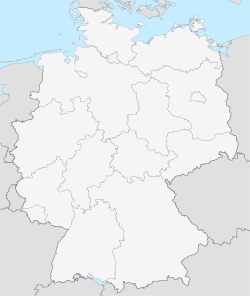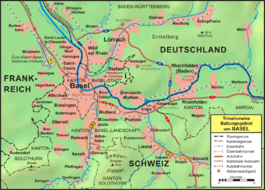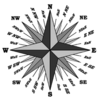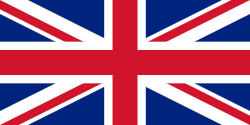Lörrach
| Lörrach | |
| Coat of arms | Location |
 |
 |
| Administration | |
| Country | Germany |
|---|---|
| State | Baden-Württemberg |
| Admin. region | Freiburg |
| District | Lörrach |
| Mayor | Gudrun Heute-Bluhm (CDU) |
| Basic statistics | |
| Area | 39.43 km² (15.2 sq mi) |
| Elevation | 294 m (965 ft) |
| Population | 47,438 (30/12/2006)[1] |
| - Density | 1,203 /km² (3,116 /sq mi) |
| Other information | |
| Time zone | CET/CEST (UTC+1/+2) |
| Licence plate | LÖ |
| Postal codes | 79501-79541 |
| Area codes | (+49) 07621 |
| Website | loerrach.de |
| Lörrach and surroundings | |
 |
|
Lörrach is a city in southwest Germany, in the valley of the Wiese, close to the French and the Swiss border. It is the capital of the district Lörrach in Baden-Württemberg. The biggest industry is the chocolate factory Milka. The city had a population of 10,794 in 1905, and now 47,438 (2006).
Nearby is the castle of Rötteln on the Wiesental, whose lords became the counts of Hachberg and a residence of the Margraves of Baden; this was destroyed by the troops of Louis XIV in 1678, but was rebuilt in 1867. Lörrach received market rights in 1403, but did not obtain the privileges of a city until 1682.
After the Napoleonic epoch, the town was included in the Grand Duchy of Baden. On 21 September 1848, Gustav Struve made an attempt to start a revolutionary uprising in Lörrach as part of the Revolutions of 1848-49. It failed, and Struve was caught and imprisoned. Still, Lörrach was officially the capital of Germany for a day.
Lörrach is the hometown of Ottmar Hitzfeld, one of the most successful and most popular football managers in Germany.
Contents |
Geography
Lörrach is located in the most southern part of the Rhine rift. The depression is created by tectonic movements and the area has a high earthquake risk. Several times at the year Lörrach is afflicted by slight and medial earthquakes.
The city is located in a valley of the Quaternary period. Lörrach is surrounded by slopes on two sides. The slopes create the southern part of the Wiesental. The river of the same name (Wiese) flows through the valley.
Geographical locations of the subdistrict Lörrach:
- Elevation of the deepest place: 272 m (In the valley Wiesental at the border to Switzerland)
- Elevation of the highest place: 570 m (In the forest of Rötteln)
The extension of the urban area from south to north is 6.0 km and from east to west 4.6 km. Lörrach is also the capital city of Markgräflerland and a part of the trinational agglomeration area of Basel. Stuttgart is 220 km away from Lörrach and it takes one hour to drive to Berne and Zürich. The city has several forested hills along the valley Wiesental: Schädelberg, Homburg, Röttler Wald and Tüllinger Berg.
Lörrach is bounded by many municipalities and the city of Basel. In addition it is located at the foothills of the Black Forestand at the border of Switzerland.
| Binzen | Rümmingen | Steinen |
| Weil am Rhein |  |
Rheinfelden |
| Basel | Riehen | Grenzach-Wyhlen |
Climate
Lörrach's climate is mild, and in the summer it is often hot. The region of Marktgräflerland is the warmest in Germany because of the Mediterranean air current from the valley of the Rhône River. Because of its numerous sunny days, the region gets the moniker of the German Tuscany (German: Die Toskana Deutschlands).
Boroughs and districts
Lörrach is subdivided into 3 boroughs and 3 districts. In sum the three boroughs have an area of 18,6 km².
| Year of incorporation |
Boroughs and districts | Area (km²) |
|---|---|---|
| 1935 | Borough Tumringen | |
| 1935 | Borough Tüllingen | 18,6 |
| 1908 | Borough Stetten | |
| 1974 | District Haagen | 3.6 |
| 1975 | District Brombach | 9.8 |
| 1975 | District Hauingen | 7.4 |
The three districts have their own administrations with a chief magistrate (Ortsvorsteher). Every five years the citizens of Lörrach elect the council of the districts. The satellite city Salzert was developed in 1963. Inlinzigen, close to Lörrach, is an independent municipality, but Lörrach oversees its administration.
History
| Year | Event |
|---|---|
| 1102 | Lörrach was first mentioned as settlement Lorracho. |
| 1403 | Declared a market town by means of Rupert of Germany. |
| 1678 | The castle of Rötteln was destroyed by the French. |
| 1682 | Lörrach got the German town law by Frederik VII of Baden-Durlach. |
| 1702 | Battle of Käferholz against the French. |
| 1756 | The town got a new town law and the first town hall. |
| 1783 | Johann Peter Hebel becomes a teacher at the boarding school. |
| 1803 | Stetten is now a part of Baden, having previously belonged to Austria. |
| 1808 | In Lörrach, numerous classicist buildings are built (synagogue, Stadtkirche and Fridolinskirche) |
| 1835 | The state Baden joins the Zollverein. |
| 1848 | In September Gustav Struve declares the new German Republic from the town hall of Lörrach after the failed revolution. Some days later he is arrested. |
| 1862 | The Wiesentalbahn between Basel, Lörrach, and Schopfheim is opened. A railway connection to Weil and Säckingen is extended to Lörrach in the year 1890. |
| 1863 | Lörrach becomes a district town. |
| 1871 | The first elementary school is opened. |
| 1880 | Philippe Suchard creates a chocolate factory in Lörrach. |
| 1908 | Incorporation of Stetten; later, Tüllingen und Tumringen (1935), Haagen (voluntary 1974), Brombach und Hauingen (1975), are incoporated. |
| 1945 | Air raid on Brombach and Lörrach. On 24 April French troops occupy the city. |
| 1963 | Start of construction of the district of Salzert. |
| 1983 | The fourth Landesgartenschau of Baden-Wuerttemberg (a national horticultural show) is held in the new park area in the Grütt. |
| 1984 | The finished motorway section between High Rhine and Upper Rhine relieves the heavy traffic of the city. |
| 1991 | Inauguration of the new pedestrian precinct and the transformation of the city center. |
Population development
|

Population development
|
source: Statistisches Landesamt Stuttgart, Statistischer Jahresbericht der Stadt Lörrach.[2]
Coat of arms

Lörrach received city rights in 1682 when it became the capital of the Oberamt Rötteln-Sausenberg. At the same time its arms were granted. The arms show a canting lark (Lerche). In 1756 both the city rights and the arms were re-granted by Count Karl Friedrich of Baden. The colours are also the colours of Baden. Even though the arms have not changed since, the shape and size of the lark have changed considerably. The present arms are used since the early 1960s and show a very modern variation of the lark. After the municipal reforms the arms were reconfirmed on November 11, 1975.
Religion
Christianity:
Lörrach belonged at first to the diocese of Konstanz and was subordinated to the archdiocese of Breisgau. In 1529, after the Reformation had been introduced there, the parsonage of Lörrach was occupied from Basel. The reformation in the city was introduced in 1556. After that, Lörrach was for many centuries a predominantly Protestant city. In Rötteln an archdiocese had existed since the beginning of the 15th century that, at the end of the 17th century, shifted to Lörrach. The Protestant parson of Lörrach was from 1682 an intendant, too. The Stadtkirche is the main church of Lörrach (first mentioned in the 12th century). In addition, Lörrach has a few parishes: Johannespfarrei (founded in 20th century), Pauluspfarrei for the northern city (founded in 1906), Matthäuspfarrei for the eastern city, Inzlingen (founded in 1949), Markuspfarrei (founded in 1956), Salzertgemeinde (founded in 1969), and Friedensgemeinde for the district of Homburg (founded in 1974).
The borough of Stetten was controlled by Austria until 1803. Therefore Stetten has a Catholic tradition, although the reformation had been introduced years before. Because of a contract with Austria Stetten became again Catholic. At first the parish Stetten looked also after the resident catholics of Lörrach. They celebrated their church services in the new church, the Fridolinskirche (1822). The original church of Stettens was founded in the 13th century. Between 1864 and 1867 in Lörrach its own parish church (St Bonifatius) was built, at which a curate were created, which was raised in 1882 to a parsonage. A second catholic church (St Peter) was built in 1964. In Brombach they already built in 1900 a church (St Josephskirche), which is since 1911 a parsonage. All catholic parishes of Lörrach form today together with the neighbour parishes St. Peter and Paul in Inzlingen a cure of souls inside the deanery Wiesental of the archbishopric Freiburg.
Today there is a slight predominance of the Evangelist denomination. In the borough Stetten exists a relative catholic majority.
Beside the two large churches there are also parishes, which belong to free churches. For example the Freie evangelische Gemeinde or FeG Lörrach (English: Free Evangelist community).
Politics
Political proportion

The municipal council of Lörrach consists 32 honorary aldermen and alderwomen, whose chairman is the Oberbürgermeisterin (mayor). The municipal council is elected for a period of five years by the citizenry.
The last election from 13 June 2004 had a percentage of voting of 41.2% and resulted in the following allocation of seats in the city hall of Lörrach:
| Party | Proportion | * | Seats | * |
|---|---|---|---|---|
| CDU | 33.3% | -5.0% | 11 | -7 |
| SPD | 21.0% | -2.5% | 7 | -4 |
| Freie Wähler | 15.8% | +1.7% | 5 | -3 |
| GRÜNE | 15.7% | +4.0% | 5 | ±0 |
| FDP | 8.0% | +5.1% | 2 | +1 |
| KUL (1) | 6.1% | -0.5% | 2 | -1 |
| total | 100% | 32 | -14 |
Source:[3]
(1) Kommunale Unabhängige Liste (English: Municipal autonomous list)
* variance to the municipal council elections of 1999.
Heads of city
The chronicle of Lörrach reports of a Johann von Schallbach in the year 1366 as first Vogt. The office designation of mayors was reserved for the local chiefs of the cities. As first mayor of Lörrach is Marx Christoph Leibfried called in the year of the first German town law of the city in 1682. He was employed by the Markgraf. Since 1956 the city head is the Oberbürgermeister, who are selected directly by the citizens.
Mayors since 1804
| Curatorship | Name | Curatorship | Name | |
|---|---|---|---|---|
| 1804 - 1807 | Johann Martin Strohmeier | 1861 - 1863 | Karl Wenner | |
| 1807 - 1810 | Johann Jakob Grether | 1863 - 1869 | Paul Feldkirchner | |
| 1810 - 1814 | Johann Kaspar Schöffel | 1869 - 1871 | Karl Robert Gebhardt | |
| 1814 - 1820 | Johann Georg Grether | 1872 - 1906 | Johann Josef Grether | |
| 1820 - 1826 | Jakob Rupp | 1906 - 1927 | Dr. Erwin Gugelmeier * | |
| 1826 - 1831 | Friedrich Hüglin | 1927 - 1933 | Dr. Heinrich Graser | |
| 1831 - 1832 | Ernst Schultz | 1933 - 1945 | Reinhard Boos | |
| 1832 - 1835 | Johann Georg Grether | 1945 - 1948 | Joseph Pfeffer | |
| 1835 - 1841 | Ernst Schultz | 1948 - 1960 | Arend Braye * | |
| 1841 - 1844 | Friedrich Hüglin | 1960 - 1984 | Egon Hugenschmidt * | |
| 1844 - 1849 | Karl Wenner | 1984 - 1995 | Rainer Offergeld * | |
| 1849 - 1861 | Johann Ludwig Calame | 1995 - 2009 | Gudrun Heute-Bluhm * |
Source:[4]
* Oberbürgermeister
Twin cities
 Sens, France (since 1966)
Sens, France (since 1966) Senigallia, Italy (since 1986)
Senigallia, Italy (since 1986) Meerane, Germany (since 1990)
Meerane, Germany (since 1990) Chester, England (since 2002)
Chester, England (since 2002)
Numerous meetings take place annually and exchanges between schools and associations. The Hebel Gymnasium School in Lörrach takes part in an annual school exchange with The Mountbatten School in Romsey, England. To Wyschgorod in the Ukraine exists besides a friendly connection. In the year 2004 Lörrach International was created, an association for the advancement of the partnerships between cities and international friendships. In the year 2006 a culture partnership was substantiated to Edirne in Turkey.
Economics and infrastructure
The town offers approximately 18,300 jobs. Retailers gained a business volume of 342,7 millions euro in the year 2004. Approximately a fifth of this business volume was generated by customers from Switzerland.
Transportation

Bundesautobahn 98 passes Lörrach. Thereby it has a direct connection to the Bundesautobahn 5 and to the A35 autoroute in France. The A2 motorway and the A3 motorway of Switzerland are also in the near of Lörrach. The Bundesstraße B 317, from Titisee-Neustadt across the pass of the Feldberg, is the most important arterial road of the City. The Bundesstraße 317 is interrupted by the national territory of Switzerland. At present the B 317 is built through this national territory as duty-free road.
In Lörrach there is a terminal, where car-drivers can travel together with their cars by train. The terminal connects Lörrach with Hildesheim, Bremen, Hamburg and Berlin. The railway connections Linie S5 (Weil am Rhein - Lörrach - Steinen) and Linie S6 (Basel SBB - Lörrach - Steinen - Zell im Wiesental) - called the red line - are parts of the Regio S-Bahn Basel. In 2005 the railway station was renovated and was developed suitable for the handicapped. The modern Stadler FLIRT-Trains of the SBB-CFF-FFS used since 2005. From 1919 to 1939 as well as from 1947 to 1967 the Line 6 of the tram of Basel operated as urban tram of Lörrach. Into the bargain Lörrach has some local and regional bus connections. They belong to the Regio Verkehrsverbund Lörrach. The next international airport, the EuroAirport Basel-Mulhouse-Freiburg, is 14 km away from Lörrach.
Administrative bodies, organisations and courts
Lörrach, as district accommodates the district administration office and a highway maintenance depot. Lörrach has several schools of all school types: A Folk high school, a municipal library with over 65,000 books, a scientific Staatsbibliothek, a school of music and two another libraries. The local court of Lörrach is responsible for cities and municipalities in the district. Furthermore there is a labour court in Lörrach, which practises the jurisdiction in first instance for the districts Lörrach and Waldshut. In addition there are three Superior Courts of Justice in Radolfzell am Bodensee. Lörrach has also a tax office, a labour office, a motorway police (German: Autobahnpolizei) and a criminal investigation department. On the 1 January 1994 the three hospitals Lörrach, Rheinfelden and Schopfheim were pooled into a GmbH. The Lörracher hospital was opened on 1 October 1845, at that time as urban infirmary; today the hospital Lörrach has 351 beds.
Companies in Lörrach
The largest company and employer in Lörrach is the chocolate manufacturer Kraft Foods Deutschland GmbH, well-known for the trademarks Milka and Suchard. A second important company is GABA, a Pharmaceutical company which produces the famous Elmex and Aronal toothpaste. Other companies:
- KBC, textile finishing company
- Midro, producer of laxative tea
- Migros, the headquarter of Migros Germany is in Lörrach
- Brauerei Lasser GmbH, a brewery with 70 employees
Media
Print Media: Two daily newspapers based in Lörrach with a local editorial office: Badische Zeitung and Die Oberbadische. Die Oberbadische (former: Oberbadisches Volksblatt) with publishing place in the city is the oldest newspaper of Lörrach (since 1885). In addition the Oberbadische Verlagshaus publishes the two newspapers Weiler Zeitung und Markgräfler Tagblatt. The city magazine Puls is published monthly and reports about events in and around Lörrach.
Broadcast and television: The radio programme of Südwestrundfunk has a regional office in Lörrach. There they producing parts of the radio program SWR4 Baden-Wuerttemberg.
Personalities
Born in Lörrach
- Melanie Behringer (* 1985))
- Sebastian Deisler (* 1980)
- Richard Geppert (* 1963)
- Ottmar Hitzfeld (* 1949)
- Ferdinand Hitzig (1807–1875)
- Paul Hübner (1915–2003)
- Jörg Kachelmann (* 1958)
- Thilo Muster (* 1965)
- Hartmut Rosa (* 1965)
- Hans-Peter Schwarz (* 1934)
- Hans Silvester (* 1938)
- Gustav Hugo (1764–1807)
- Heinz Zuber (* 1941)
Others
- Hermann Burte (1879–1960)
- Marion Caspers-Merk (* 1955)
- Gustav Struve (1805–1870)
- Johann Peter Hebel (1760–1826)
- Egon von Neindorff (1923–2004)
- Rainer Offergeld (* 1937)
- Roland Wiesendanger (* 1961)
- Henning Wiesner (* 1944)
Destruction
Lorrach is also the home town of German thrash metal band Destruction formed in 1984 and still running today,it is the leader in the German thrash metal movement.
Sources
- ↑ "Annual area and population data for Lörrach" (in German). Statistisches Landesamt Baden-Württemburg. Retrieved on 2008-01-21.
- ↑ Population development from Statistischen Landesamt Stuttgart
- ↑ Results of the municipal council election of 2004
- ↑ Lörrach: Landschaft - Geschichte - Kultur, Seite 683 f
External links
- Official website (German)
- (German) Lörrach:History and images
- Lörrach Civic Heraldry
- Newspaper of the area
- News and musings from Weil am Rhein - German town near Loerrach on the Basle border triangle
- Burg Rötteln: Picture Gallery
|
|||||||